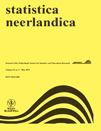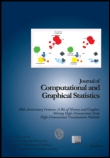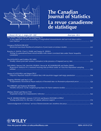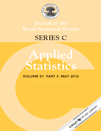
STATISTICAL MODELLING
Scope & Guideline
Innovating Methodologies for Tomorrow's Challenges
Introduction
Aims and Scopes
- Innovative Statistical Methods:
The journal publishes articles that introduce new statistical methodologies, including non-traditional regression models, Bayesian approaches, and mixed effects models that are applicable in various research fields. - Application of Statistical Models:
Research articles often demonstrate the application of statistical models in real-world scenarios, such as epidemiological studies, sports analytics, and economic forecasting, highlighting the practical importance of statistical theory. - Focus on Complex Data Structures:
The journal addresses the challenges posed by complex data types, including longitudinal, hierarchical, and spatial data, paving the way for the development of robust statistical techniques to handle such complexities. - Interdisciplinary Research:
'Statistical Modelling' encourages interdisciplinary research by publishing studies that integrate statistical methods with fields such as healthcare, finance, and environmental science, thereby broadening the impact of statistical innovations. - Bayesian and Nonparametric Approaches:
The journal has a strong emphasis on Bayesian methodologies and nonparametric models, reflecting a trend towards flexible and adaptive model frameworks that can accommodate uncertainty and complex data structures.
Trending and Emerging
- Bayesian Hierarchical Models:
There is a growing trend towards the use of Bayesian hierarchical models, which allow for the incorporation of prior information and the handling of complex data structures, particularly in fields like healthcare and social sciences. - Machine Learning Integration:
Recent publications indicate an increasing integration of machine learning techniques with traditional statistical modeling, especially in model selection and prediction, reflecting a shift towards data-driven approaches. - Quantile Regression Techniques:
Quantile regression is gaining traction as researchers seek to understand the impact of variables across different quantiles of the response distribution, providing a more nuanced analysis than traditional mean-based approaches. - Complex Time Series Analysis:
An emerging focus on sophisticated time series models, including GARCH and INGARCH frameworks, is evident, as researchers aim to capture dynamic relationships in financial and environmental data. - Spatial and Spatio-temporal Modeling:
The journal is increasingly publishing articles on spatial and spatio-temporal models, which are essential for analyzing data that varies across both space and time, particularly in fields like epidemiology and ecology.
Declining or Waning
- Traditional Statistical Techniques:
There has been a noticeable decline in the prevalence of classical statistical methods, such as basic linear regression and ANOVA, as researchers increasingly favor more complex and flexible modeling approaches. - Focus on Simpler Models:
The journal has seen a reduction in papers dedicated to simpler statistical models, as the trend shifts towards developing and applying advanced models that can capture intricate relationships in data. - Generalized Linear Models (GLMs):
While still relevant, the publication of research centered solely on GLMs has decreased, as more sophisticated modeling frameworks are being adopted in the statistical community. - Descriptive Statistics:
There is a waning interest in purely descriptive statistical analyses, which are being overshadowed by the demand for inferential and predictive modeling techniques that provide deeper insights into data. - Fixed Effect Models:
The application of fixed effects models has become less common, as more researchers are exploring random effects and mixed models that account for variability across different levels of data.
Similar Journals

STATISTICA SINICA
Your Gateway to Premier Statistical ResearchSTATISTICA SINICA, published by the esteemed STATISTICA SINICA organization, stands as a premier journal in the fields of Statistics and Probability, boasting a significant impact within the academic community. With an ISSN of 1017-0405 and E-ISSN of 1996-8507, this journal has evolved from its inception in 1996, continuing to publish cutting-edge research through 2024. As recognized by its recent categorization in Q1 quartiles in both Statistics and Probability and Statistics, Probability and Uncertainty for 2023, it ranks among the top journals in its discipline, meriting attention from researchers and practitioners alike. Despite lacking open access options, it delivers rigorous, peer-reviewed articles that contribute to the advancement of statistical science. With its base in Taiwan, and a dedicated editorial team located at the Institute of Statistical Science, Academia Sinica, Taipei, STATISTICA SINICA continues to be a vital resource for statisticians, data scientists, and related professionals seeking innovative methodologies and insights within this dynamic field.

JIRSS-Journal of the Iranian Statistical Society
Fostering Collaboration for a Stronger Statistical Community.JIRSS - Journal of the Iranian Statistical Society is a prominent academic journal dedicated to the field of statistics and probability, published by the esteemed Iranian Statistical Society. With its ISSN number 1726-4057 and E-ISSN 2538-189X, this journal serves as a vital platform for disseminating cutting-edge research and advancements in statistical methodology and its applications. Established in 2011, JIRSS has consistently contributed to the academic community, achieving a 2023 Scopus rank of #180 out of 278 in its category, placing it within the 35th percentile in the dynamic domain of Mathematics: Statistics and Probability. As an Open Access publication, it enhances accessibility for researchers, professionals, and students, facilitating a wider engagement with innovative statistical techniques and theories. The journal aims to foster collaboration and knowledge exchange among statisticians, ultimately enriching the field and its impact on various scientific disciplines.

TEST
Exploring the frontiers of probability and statistics.TEST, published by Springer, is a prestigious academic journal that serves as a vital platform for research in the fields of Statistics and Probability. With an ISSN of 1133-0686 and an E-ISSN of 1863-8260, TEST has been at the forefront of statistical methodology and applications since its inception in 1992. As of 2023, the journal holds a Q2 ranking in both the Statistics and Probability, and Statistics, Probability and Uncertainty categories, affirming its position among the leading scholarly publications in these domains. Although it currently does not offer open access, its rich repository of peer-reviewed articles and innovative research findings continues to attract attention from researchers, professionals, and students alike. Positioned within the competitive landscape of mathematical sciences, TEST aims to advance both theoretical developments and practical applications in statistical science through high-quality publications. Researchers can greatly benefit from the insights and methodologies presented within its pages, as elucidated by its Scopus rankings, placing it in the 56th percentile for Mathematics in Statistics and Probability and 53rd for Decision Sciences. For further inquiries, TEST is headquartered at One New York Plaza, Suite 4600, New York, NY 10004, United States, where it continually strives to contribute to the evolution of statistical research.

STATISTICA NEERLANDICA
Advancing statistical science through rigorous scholarship.STATISTICA NEERLANDICA is a prestigious peer-reviewed journal published by Wiley, focusing on the fields of statistics and probability. Established in 1946 and addressing key issues in statistical theory and its applications, the journal has significantly contributed to the development of modern statistical practices. With an impressive Q2 categorization in both Statistics and Probability, as well as Statistics, Probability, and Uncertainty, STATISTICA NEERLANDICA stands out within its field, ranking in the 62nd percentile among its peers in mathematics, specifically in statistics and probability. Researchers, professionals, and students can benefit from its rigorous scholarship and innovative methodologies, aiding in the advancement of statistical science. Although the journal does not operate under an open access model, it maintains a commitment to disseminating high-quality research, making it a vital resource for those engaged in statistical inquiry.

STATISTICS
Connecting theory and practice in the world of statistics.STATISTICS is a distinguished journal published by Taylor & Francis Ltd, dedicated to advancing the field of statistical science since its inception in 1985. With a strong focus on both the theoretical and practical aspects of Statistics and Probability, this journal serves as a vital platform for researchers, professionals, and students seeking to disseminate their findings and contribute to critical discussions in the discipline. Although categorized in the Q3 quartile for both Statistics and Probability and Statistics, Probability and Uncertainty, the journal's commitment to quality research is evidenced by its inclusion in relevant Scopus rankings. It holds respectable positions, ranked #132/168 in Decision Sciences and #219/278 in Mathematics. By providing a venue for high-quality research articles and reviews, STATISTICS aims to foster innovation, reinforce methodological advancements, and address contemporary challenges in statistical applications. The journal does not currently offer open access, but it is widely distributed, ensuring that significant research reaches the communities that need it most. Researchers are encouraged to submit their work to this essential resource that continues to shape the landscape of statistical inquiry.

Electronic Journal of Statistics
Transforming Data into KnowledgeElectronic Journal of Statistics, published by INST MATHEMATICAL STATISTICS-IMS, is a premier open-access platform dedicated to the field of statistics and probability, with a remarkable track record since its inception in 2007. With an ISSN of 1935-7524, this journal has quickly established itself as a leading resource within the top Q1 category in both Statistics and Probability, as well as Statistics, Probability and Uncertainty, highlighting its significance and impact in the academic community. The journal’s commitment to disseminating high-quality research allows researchers, professionals, and students to access valuable findings and methodologies that contribute to the advancement of statistical sciences. With its convergence set to continue until 2024, the Electronic Journal of Statistics remains a vital source for scholars looking to enrich their knowledge and engage with cutting-edge statistical theories and applications.

Thailand Statistician
Empowering Research Through Innovative Statistical InsightsThailand Statistician, published by the THAI STATISTICAL ASSOCIATION, is a pivotal journal in the realms of computational mathematics and statistics. With an ISSN of 1685-9057 and an E-ISSN of 2351-0676, this journal aims to disseminate high-quality research and innovative methodologies that advance the fields of statistics and probability. Covering a range of topics from theoretical statistics to applied computational techniques, it provides a platform for researchers, professionals, and students in Thailand and beyond to contribute their findings and insights. The journal has been gaining recognition, boasting a Scopus ranking of Q3 in Computational Mathematics and Q4 in Statistics and Probability as of 2023. With its commitment to open access, the Thailand Statistician stands as an essential resource for those striving to stay abreast of advancements in statistical methodologies and their applications, fostering the growth of statistical science in the region and globally.

JOURNAL OF COMPUTATIONAL AND GRAPHICAL STATISTICS
Fostering excellence in data science and statistical discourse.JOURNAL OF COMPUTATIONAL AND GRAPHICAL STATISTICS is a premier academic publication dedicated to advancing the fields of computational statistics and graphical data representation. Published by Taylor & Francis Inc, this journal stands out with its impressive Q1 rankings in Discrete Mathematics and Combinatorics, Statistics and Probability, and Statistics, Probability and Uncertainty, reflecting its high impact and relevance in contemporary research. Since its inception in 1992, the journal has been a vital resource for researchers, professionals, and students alike, with its rigorous peer-reviewed articles contributing significantly to the science of data analysis and visualization. With a Scopus ranking placing it within the top tiers of its category, the journal is committed to disseminating high-quality research that promotes innovation and methodological advancement. Note that the journal currently follows a traditional subscription model, ensuring focused and curated content for its readers. As it approaches the horizon of 2024, the JOURNAL OF COMPUTATIONAL AND GRAPHICAL STATISTICS continues to foster scholarly discourse and discoveries, making it an essential platform for anyone involved in statistics and data science.

CANADIAN JOURNAL OF STATISTICS-REVUE CANADIENNE DE STATISTIQUE
Illuminating Trends in Statistics for Over Four DecadesCanadian Journal of Statistics - Revue Canadienne de Statistique is a prestigious publication in the field of statistics, managed by Wiley. Since its inception in 1973, this journal has served as an essential resource for researchers, practitioners, and students, offering insights into a diverse range of statistical methodologies and applications. With its impact reflected in its 2023 categorization as Q2 in Statistics and Probability and Q3 in Statistics, Probability and Uncertainty, the journal stands out among its peers, exemplifying rigorous standards in empirical research. The journal's ISSN is 0319-5724 and its E-ISSN is 1708-945X, providing a robust platform for the dissemination of knowledge in the field. While it does not offer open access, the journal remains highly regarded and well-cited, contributing significantly to the advancement of statistical theory and practice. As it continues to publish cutting-edge research through to 2024, the Canadian Journal of Statistics is a must-read for anyone seeking to stay informed on the latest trends and developments in statistics.

JOURNAL OF THE ROYAL STATISTICAL SOCIETY SERIES C-APPLIED STATISTICS
Elevating Statistical Applications for Today's ChallengesThe JOURNAL OF THE ROYAL STATISTICAL SOCIETY SERIES C - APPLIED STATISTICS, published by the Oxford University Press, serves as a critical platform for disseminating innovative research within the field of applied statistics. With its ISSN 0035-9254 and E-ISSN 1467-9876, this journal provides a comprehensive resource for statisticians and practitioners alike, focusing on the development and application of statistical methodologies to real-world problems. As of 2023, it is ranked in the Q2 quartile within both the Statistics and Probability categories, reflecting its significant contribution to the discipline as evidenced by its Scopus ranking. Although it does not offer open access, the journal maintains a rigorous peer-review process and publishes issues regularly, with coverage extending from 1981 to 2024. By focusing on practical applications of statistical methods, the journal aims to bridge the gap between theory and application, making it an essential read for researchers, professionals, and students who are keen on advancing their understanding of statistics in various domains.